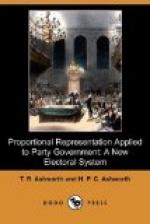Sir John Lubbock points out that the element of chance might be eliminated by distributing the second votes proportionally to the second choices on the whole 1,100 papers, and that it might be desirable to leave any candidate the right to claim that this should be done if he thought it worth while.
+2.—The Hare-Clark Method.+—The Hare system has been in actual use in Tasmania for the last two elections. It is applied only in a six-seat electorate at Hobart and a four-seat electorate at Launceston. The rules for distributing surplus votes proportionally were drawn up by Mr. A.I. Clark, late Attorney-General. The problem is not so simple as it appears at first sight. There is no difficulty with a surplus on the first count; it is when surpluses are created in subsequent counts by transferred votes that the conditions become complicated. Mr. Clark adopts a rule that in the latter case the transferred papers only are to be taken into account in deciding the proportional distribution of the surplus. Suppose, as before, the quota to be 1,000 votes, and a candidate to have 1,100 votes, 550 of which are marked in the second place to one of the other candidates. Then the latter is entitled to 50 of the surplus votes, and a chance selection is made of the 550 papers. The element of chance still remains, therefore, if this surplus contributes to a fresh surplus.
+3.—The Droop-Gregory Method.+—This method, advocated by Professor Nanson, of the Melbourne University, is claimed to entirely eliminate the element of chance. The Gregory plan of transferring surplus votes is defined as a fractional method. If a candidate needs only nine-tenths of his votes to make up his quota, instead of distributing the surplus of one-tenth of the papers all the papers are distributed with one-tenth of their value. Reverting to our former example, if a candidate is marked second on 550 out of 1,100 votes, the quota being 1,000 and the surplus 100, then instead of selecting 50 out of the 550 papers, the whole of them would be transferred in a packet, the value of the packet being 50 votes, or, as Professor Nanson prefers to put it, the value of each paper in the packet being one-eleventh of a vote. Should this packet contribute to a new surplus the third choices on the whole of the papers are available as a basis for the redistribution. The packet would be divided into smaller packets, and each assigned its reduced value. It might here be pointed out that the use of fractions is quite unnecessary, the value of each packet in votes being all that is required, and that the-same process may be used with the Hare-Clark method to avoid the chance selection of papers. The only real difference is this: that when a surplus is created by transferred votes Mr. Clark distributes it by reference to the next preference on all the transferred papers, and Professor Nanson by reference to the last packet of transferred papers only—the packet which raises the candidate above the quota.




